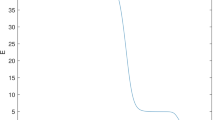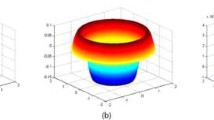Abstract
We consider various approximations of artificial boundary conditions for linearized Benjamin–Bona–Mahony BBM equation. Continuous (respectively discrete) artificial boundary conditions involve non local operators in time which in turn requires to compute time convolutions and invert the Laplace transform of an analytic function (respectively the \(\mathcal {Z}\)-transform of an holomorphic function). In this paper, we derive explicit transparent boundary conditions both continuous and discrete for the linearized BBM equation. The equation is discretized with the Crank Nicolson time discretization scheme and we focus on the difference between the upwind and the centered discretization of the convection term. We use these boundary conditions to compute solutions with compact support in the computational domain and also in the case of an incoming plane wave which is an exact solution of the linearized BBM equation. We focus on and prove consistency, stability and convergence of the numerical scheme and provide many numerical experiments to show the efficiency of our transparent boundary conditions.










Similar content being viewed by others
References
Abdallah, N.B., Méhats, F., Pinaud, O.: On an open transient Schrödinger–Poisson system. Math. Models Methods Appl. Sci. 15, 667 (2005)
Achouri, T., Khiari, N., Omrani, K.: On the convergence of difference schemes for the Benjamin Bona Mahony BBM equation. Appl. Math. Comput. 182(2), 999–1005 (2006)
Alazman, A.A., Albert, J.P., Bona, J.L., Chen, M., Wu, J.: Comparisons between the BBM equation and a Boussinesq system. Adv. Differ. Equ. 11(2), 121–166 (2006)
Antoine, X., Arnold, A., Besse, C., Ehrhardt, M., Schädle, A.: A review of transparent and artificial boundary conditions techniques for linear and nonlinear Schrödinger equations. Commun. Comput. Phys. 4, 729–796 (2008)
Arnold, A.: Numerically absorbing boundary conditions for quantum evolution equations. VLSI Des. 6, 313–319 (1998)
Arnold, A., Ehrhardt, M., Sofronov, I.: Discrete transparent boundary conditions for the Schrödinger equation: fast calculation, approximation, and stability. Commun. Math. Sci. 3, 501–556 (2003)
Besse, C., Ehrhardt, M., Lacroix-Violet, I.: Discrete Artificial Boundary Conditions for the Korteweg–de Vries Equation. Numer. Math. PDEs (2016). https://doi.org/10.1002/num.22058
Dutykh, D., Pelinovsky, E.: Numerical simulation of a solitonic gas in KdV and KdV-BBM equations. Phys. Lett. A 378(42), 3102–3110 (2004)
Eilbeck, J.C., McGuire, G.R.: Numerical study of the regularized long-wave equation. II: interaction of solitary waves. J. Comput. Phys. 23(1), 63–73 (1977)
El, G.A.: Resolution of a shock in hyperbolic systems modified by weak dispersion. Chaos Interdiscip. J. Nonlinear Sci. 15(3), 037103 (2005)
Ehrhardt, M.: Discrete Artificial Boundary Conditions. Ph.D., Technische Universität Berlin (2001)
Ehrhardt, M., Arnold, A.: Discrete transparent boundary conditions for the Schrödinger equation. Riv. Math. Univ. Parma 6, 57–108 (2001)
Ehrhardt, M.: Discrete transparent boundary conditions for Schrödinger-type equations for non-compactly supported initial data. Appl. Numer. Math. 58, 660–673 (2008)
El, G.A., Hoefer, M.A., Shearer, M.: Expansion shock solutions of the BBM and Boussinesq equations, arXiv preprint arXiv:1601.01071 (2016)
Grava, T., Klein, C.: Numerical study of a multi scale expansion of Korteweg–de Vries and Camass–Holm equation. Contemp. Math. 458, 81 (2008)
Halpern, L.: Absorbing boundary conditions for the discretization schemes of the one-dimensional wave equation. Math. Comput. 38(158), 415–429 (1982)
Jury, E.I.: Theory and Application of the z-Transform Method. Wiley, New York (1964)
Lannes, D.: The water waves problem: mathematical analysis and asymptotics. In: Mathematical Surveys and Monographs, vol 188. AMS (2013)
Lax, P.D., Levermore, D.: The small dispersion limit of the Korteweg-de Vries equation. I. Commun. Pure Appl. Math. 36(3), 253–290 (1983)
Sofronov, I.L., Podgnornova, O.V.: A spectral approach for generating non-local boundary conditions for external wave problems in anisotropic media. J. Sci. Comput. 27(1–3), 419–430 (2006)
Sofronov, I.L., Zaitsev, N.A.: Numerical generation of transparent boundary conditions on the side surface of a vertical transverse isotropic layer. J. Comput. Appl. Math. 234(6), 1732–1738 (2010)
Whitham, G.B.: Linear and Nonlinear Waves, vol. 42. Wiley, Hoboken (2011)
Zheng, C., Wen, X., Han, H.: Numerical solution to a linearized KdV equation on unbounded domain. Numer. Methods Partial Differ. Equ. 24(2), 383–399 (2008)
Acknowledgements
Research of C. Besse and P. Noble was partially supported by the ANR project BoND ANR-13-BS01-0009-01. Research of B. Mésognon-Gireau was supported by the SHOM research contract 11CR0001.
Author information
Authors and Affiliations
Corresponding author
A The \(\mathcal {Z}\)-transform
A The \(\mathcal {Z}\)-transform
The discrete analogue of the Laplace transform is the so called \(\mathcal {Z}\)-transform. In this section, we list some results used in this paper concerning this transformation. More precise details on the \(\mathcal {Z}\)-transform and its properties are given in [17].
Definition 2
Let \((u_n)_{n\in \mathbb {N}}\in \mathbb {C}^\mathbb {N}\). We define the \(\mathcal {Z}\)-transform of the sequence \((u_n)\), denoted \(\widehat{u}\) by:
where 1 / R is the convergence radius of the series \(\sum _{n=0}^\infty u_n z^n\).
Note that in the previous definition, the radius R depends a priori on the sequence \((u_n)\). We now state a couple of analogue results of the Laplace transform properties in the context of the \(\mathcal {Z}\)-transform. One has the following discrete differentiation Theorem:
Theorem 4
When these quantities are well defined, one has:
We also have the following behavior of the \(\mathcal {Z}\)-transform regarding the convolution:
Theorem 5
Let \((u_n),(v_n)\in \mathbb {C}^\mathbb {N}\). If \(\widehat{u}(z)\) exists for \(\vert z\vert >R_u\) and \(\widehat{v}(z)\) exists for \(\vert z\vert > R_v\), then \(\mathcal {Z}(u_n\star v_n)\) exists for \(\vert z\vert > \max (R_u,R_v)\) and one has:
By a classical series-integral commutation, one gets the following Plancherel Theorem:
Theorem 6
Let \((u_n),(v_n)\in \mathbb {C}^\mathbb {N}\). If \(\widehat{u}(z)\) exists for \(\vert z\vert >R_u\) and \(\widehat{v}(z)\) exists for \(\vert z\vert > R_uR_v\) with \(R_u<r< 1/R_v\), then, one has, for all \(r\in [R_u;R_v]\):
If \(R_u<1\) and \(R_v<1\), then \(r=1\) can be chosen in the above equality.
We now state the following inversion result (which is a consequence of Cauchy Integral Theorem):
Theorem 7
Let \((u_n)\) be a complex sequence and \(\widehat{u}\) its \(\mathcal {Z}\)-transform with radius of convergence \(R_u\). Then, one gets the following relation:
where \(R > R_u\) and C(0, R) denotes the circle of center 0 and radius R.
Rights and permissions
About this article
Cite this article
Besse, C., Mésognon-Gireau, B. & Noble, P. Artificial boundary conditions for the linearized Benjamin–Bona–Mahony equation. Numer. Math. 139, 281–314 (2018). https://doi.org/10.1007/s00211-017-0943-1
Received:
Revised:
Published:
Issue Date:
DOI: https://doi.org/10.1007/s00211-017-0943-1




